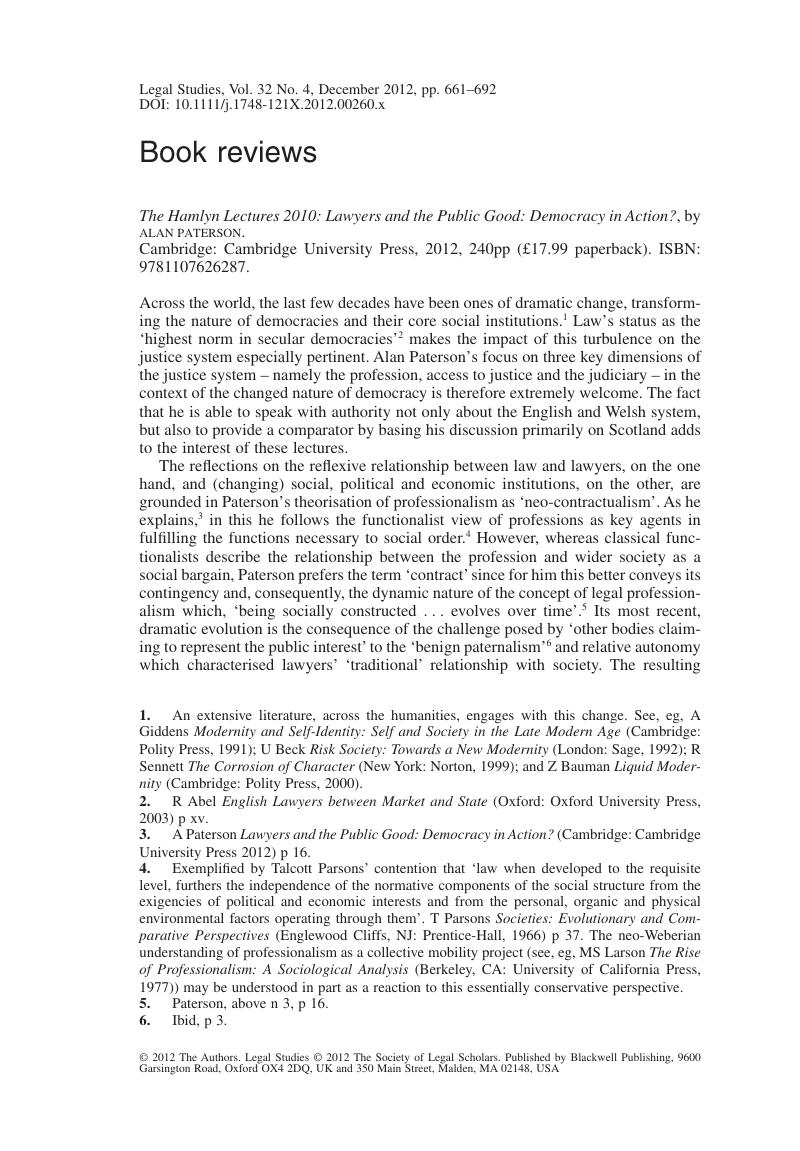No CrossRef data available.
Article contents
The Hamlyn Lectures 2010: Lawyers and the Public Good: Democracy in Action?, by Alan Paterson. Cambridge: Cambridge University Press, 2012, 240pp (£17.99 paperback). ISBN: 9781107626287.
Published online by Cambridge University Press: 02 January 2018
Abstract

- Type
- Book Review
- Information
- Copyright
- Copyright © Society of Legal Scholars 2012
References
1. An extensive literature, across the humanities, engages with this change. See, eg, Giddens, A Modernity and Self-Identity: Self and Society in the Late Modern Age (Cambridge: Polity Press, 1991)Google Scholar; Beck, U Risk Society: Towards a New Modernity (London: Sage, 1992)Google Scholar; Sennett, R The Corrosion of Character (New York: Norton, 1999)Google Scholar; and Bauman, Z Liquid Modernity (Cambridge: Polity Press, 2000).Google Scholar
2. Abel, R English Lawyers between Market and State (Oxford: Oxford University Press, 2003) p xv.Google Scholar
3. Paterson, A Lawyers and the Public Good: Democracy in Action? (Cambridge: Cambridge University Press 2012) p 16.Google Scholar
4. Exemplified by Talcott Parsons’ contention that ‘law when developed to the requisite level, furthers the independence of the normative components of the social structure from the exigencies of political and economic interests and from the personal, organic and physical environmental factors operating through them’. Parsons, T Societies: Evolutionary and Comparative Perspectives (Englewood Cliffs, NJ: Prentice-Hall, 1966) p 37.Google Scholar The neo-Weberian understanding of professionalism as a collective mobility project (see, eg, Larson, MS The Rise of Professionalism: A Sociological Analysis (Berkeley, CA: University of California Press, 1977)Google Scholar) may be understood in part as a reaction to this essentially conservative perspective.
5. Paterson, , above n 3, p 16.Google Scholar
6. Ibid, p 3.
7. Ibid.
8. Susskind, R The End of Lawyers? (Oxford: Oxford University Press, 2008) p 3 Google Scholar, cited in Paterson, , above n 3, p 6.Google Scholar
9. Wilensky, HL ‘The professionalization of everyone? (1964) 70 American Journal of Sociology 137.CrossRefGoogle Scholar And see Fournier who interprets this development from a Foucaultian perspective as a means of ‘governing employees from a distance’: Fournier, V ‘The appeal to “professionalism” as a disciplinary mechanism’ (1999) 47 Sociological Review 280.CrossRefGoogle Scholar
10. Abel, R English Lawyers between Market and State (Oxford: Oxford University Press, 2003) p 475.Google Scholar
11. Nelson, R et al Lawyers’ Ideals/Lawyers’ Practices: Transformations in the American Legal Profession (Ithaca, NY: Cornell University Press, 1992)Google Scholar, cited in Paterson, , above n 3, p 9.Google Scholar
12. However, given that these predictions are concerned precisely with the end of this ‘ideal type’ of professionalism, this observation does not diminish their significance.
13. Paterson, , above n 3, p 53.Google Scholar
14. Ibid, p 12.
15. Ibid, p 15.
16. Ibid.
17. Ibid.
18. Ibid.
19. Ibid, p 23.
20. Ibid.
21. Ibid, p 33.
22. Ibid. p 34.
23. Ibid, p 43.
24. Lord Gill, Scottish Civil Courts Review (2009), cited in Paterson, , above n 3, p 62.Google Scholar
25. Paterson, , above n 3, p 69.Google Scholar
26. Ibid, pp 120–124.
27. Ibid, p 128
28. As Professor Paterson acknowledges, this point was made by Genn in her 2008 Hamlyn Lectures. Genn, H Judging Civil Justice (Cambridge: Cambridge University Press, 2010) p 148.Google Scholar
29. Paterson, above n 3, pp 126–127. One example he gives is R (Morgan Grenfell & Co) v Special Commissioners of Income Tax [2002] UKHL 21.
30. Ibid, p 24.
31. The literature on the role of law and lawyers in both constituting the forms of capital and advancing its interest is voluminous, but see, eg, Cain, M. ‘The symbol traders’ in Cain, M and Harrington, C Lawyers in a Postmodern World (Buckingham: Open University Press, 1994)Google Scholar; Dezalay, Y ‘Professional competition and the social construction of markets’ in Dezalay, Y and Sugarman, D (eds) Professional Competition and Professional Power (London: Routledge, 1995).Google Scholar
32. Paterson, , above n 3, p 62.Google Scholar
33. The poll was commissioned by the Legal Action Group (LAG) in November 2010. Hynes, S ‘Publicly funded legal advice gets a ringing endorsement’ Law Society Gazette, 11 November 2010 Google Scholar, cited in Paterson, , above n 3, p 63.Google Scholar
34. Paterson, , above n 3, p 25.Google Scholar
35. Ibid, pp 25–26.
36. See, eg, Ackroyd, S and Muzio, D ‘The reconstructed professional firm: explaining change in English legal practices’ (2007) 48 Organization Studies 1.Google Scholar
37. See, eg, Sommerlad, H, Webley, L, Muzio, D, Tomlinson, J and Duff, E Diversity in the Legal Profession in England and Wales (London: Legal Services Board, 2010)Google Scholar; and Sommerlad, H ‘The commercialisation of law and the enterprising legal practitioner: continuity and change (2011) 18 International Journal of the Legal Profession 73.CrossRefGoogle Scholar
38. H Sommerlad ‘The professional precariat: the case of law’. Paper presented at the PROPEL Conference, May 2012, available at: http://www.propel.stir.ac.uk/downloads/HilarySommerlad-FullPaper.pdf.
39. Paterson, , above n 3, pp 56–58.Google Scholar
40. Ibid, p 57.
41. Ibid.
42. Parsons, T ‘The professions and social structure’ (1939) 17 Social Forces 457 CrossRefGoogle Scholar
43. Durkheim, E Professional Ethics and Civic Morals (London: Routledge, 1992) p 15.Google Scholar
44. Jameson, F ‘Five theses on actually existing Marxism’ Monthly Review, April 1996, at 1.CrossRefGoogle Scholar


